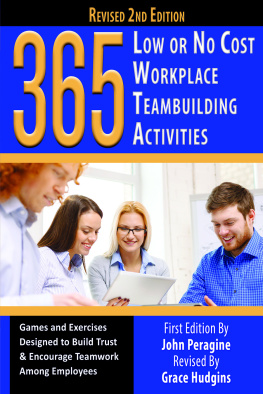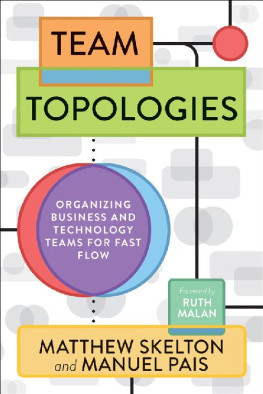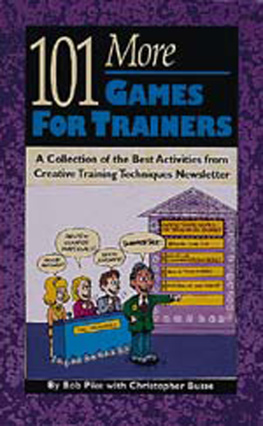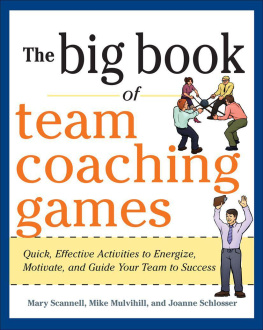Contents

Copyright 2012 by John Chen. All rights reserved.
Published by John Wiley & Sons, Inc., Hoboken, New Jersey.
Published simultaneously in Canada.
No part of this publication may be reproduced, stored in a retrieval system, or transmitted in any form or by any means, electronic, mechanical, photocopying, recording, scanning, or otherwise, except as permitted under Section 107 or 108 of the 1976 United States Copyright Act, without either the prior written permission of the Publisher, or authorization through payment of the appropriate per-copy fee to the Copyright Clearance Center, Inc., 222 Rosewood Drive, Danvers, MA 01923, (978) 750-8400, fax (978) 646-8600, or on the web at www.copyright.com . Requests to the Publisher for permission should be addressed to the Permissions Department, John Wiley & Sons, Inc., 111 River Street, Hoboken, NJ 07030, (201) 748-6011, fax (201) 748-6008, or online at http://www.wiley.com/go/permissions .
Limit of Liability/Disclaimer of Warranty: While the publisher and author have used their best efforts in preparing this book, they make no representations or warranties with respect to the accuracy or completeness of the contents of this book and specifically disclaim any implied warranties of merchantability or fitness for a particular purpose. No warranty may be created or extended by sales representatives or written sales materials. The advice and strategies contained herein may not be suitable for your situation. You should consult with a professional where appropriate. Neither the publisher nor author shall be liable for any loss of profit or any other commercial damages, including but not limited to special, incidental, consequential, or other damages.
For general information on our other products and services or for technical support, please contact our Customer Care Department within the United States at (800) 762-2974, outside the United States at (317) 572-3993 or fax (317) 572-4002.
Wiley publishes in a variety of print and electronic formats and by print-on-demand. Some material included with standard print versions of this book may not be included in e-books or in print-on-demand. If this book refers to media such as a CD or DVD that is not included in the version you purchased, you may download this material at http://booksupport.wiley.com . For more information about Wiley products, visit www.wiley.com .
Library of Congress Cataloging-in-Publication Data:
Chen, John, 1967
50 Digital Team-Building Games: Fast, Fun Meeting Openers, Group Activities and Adventures Using Social Media, Smart Phones, GPS, Tablets, and More / John Chen.
Includes index.
ISBN 978-1-118-18093-8 (pbk) ISBN 978-1-118-22737-4 (ebk) ISBN 978-1-118-24031-1 (ebk) ISBN 978-1-118-26502-4 (ebk)
1. Teams in the workplace. 2. Social groups. 3. Information technologySocial aspects. I. Title. II. Title: 50 Digital Team-Building Games.
HD66
658.4022dc23
2012000944
50 Digital Team-Building Games Quick Start
Use this Matrix to quickly find the digital team-building game that fits your needs.
Turn to the Preface and read How to Use the Games in This Book.
Run your first digital team-building game and start to reap the rewards!
How to Use This Matrix
- First determine the goal of your team-building game by choosing one of the nine major categories.
- Next, narrow by the number of people you have, the time available, and the technology you have available.
- Then use the page numbers to scan the team-building games that match your goals and criteria and choose the one that fits your needs the best.
If you have any questions, you can ask at http://50digitalteambuildinggames.com . Thank you and happy digital team building!

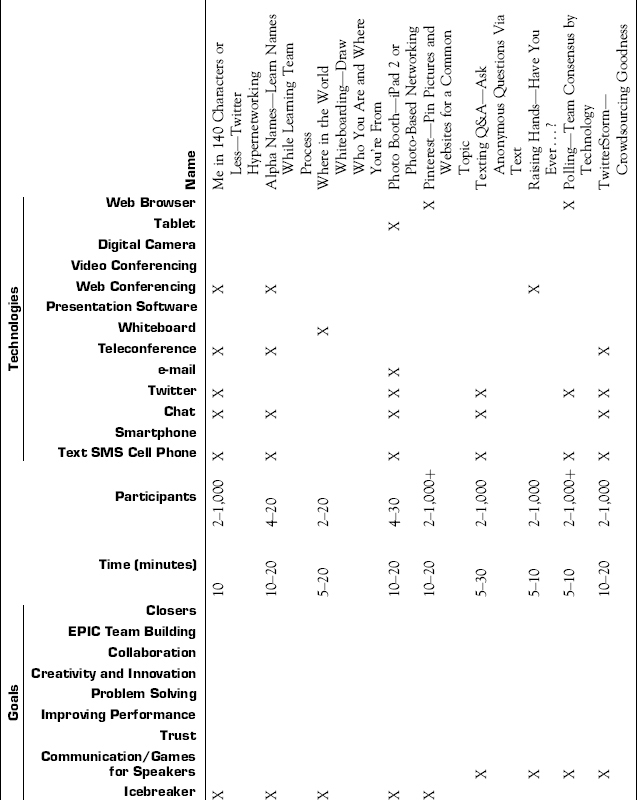
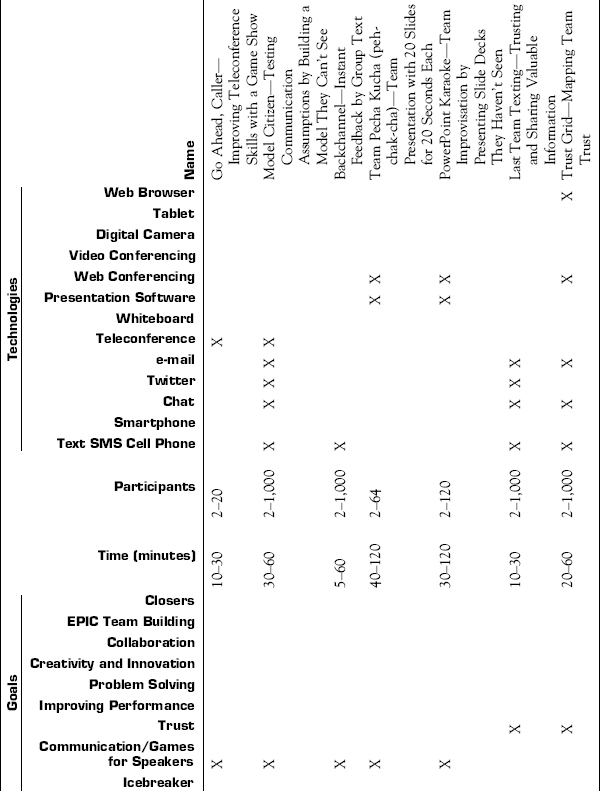
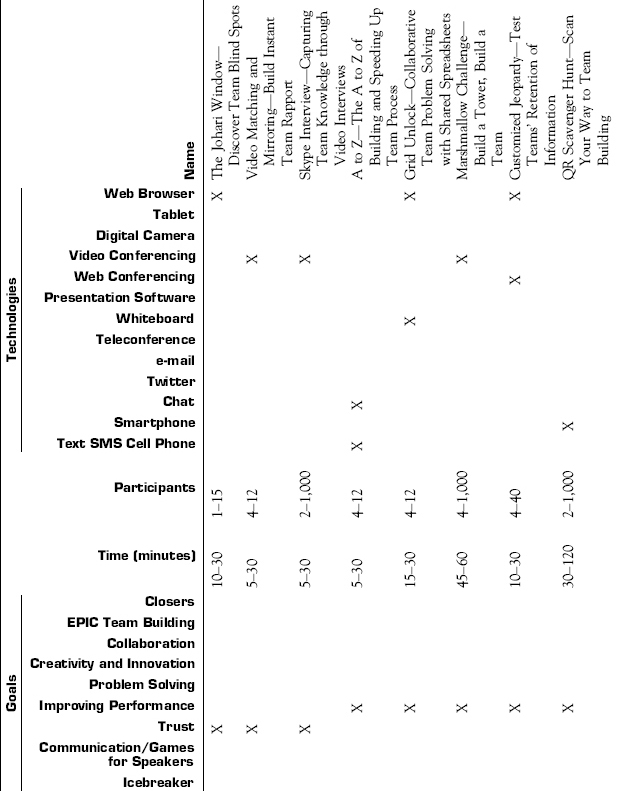
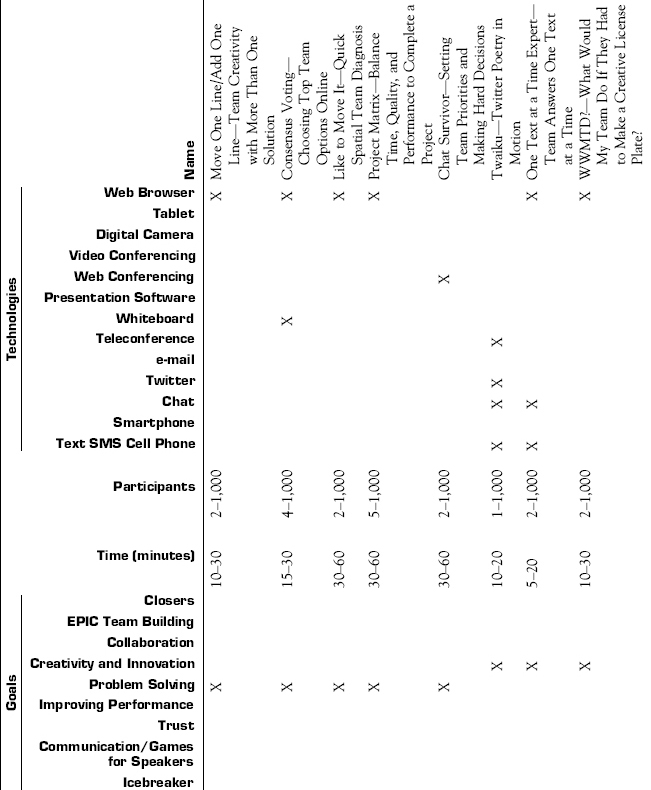
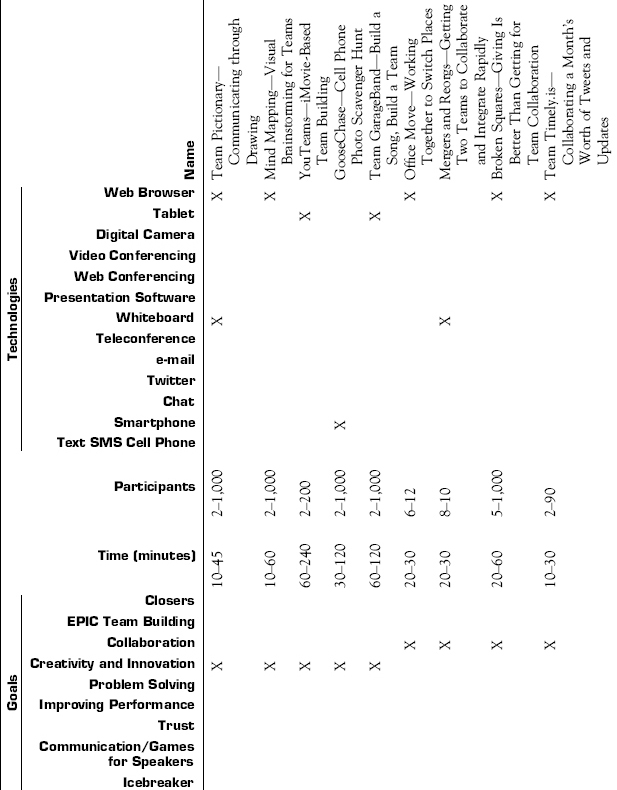

Preface: How to Use the Games in This Book
I like to tell clients that theyre investing in my company for all the mistakes well not make because weve already made them in the past. Youre buying this book to avoid all the mistakes weve already made. This chapter has a checklist for you to follow when planning any digital team-building game. Think about a PIPE when you first beginsomething that you can use to guide your teammates to a successful outcome on the other side (if you dont get clogged along the way). PIPE stands for:
- Purpose Why are you holding this team-building event? What clear goals do you have for it? What do you want the results to be?
- Initiatives or Team-building games Which games best match your goals, number of people, time available, and technology available?
- Preparation How can you best prepare yourself and your teammates so that the team-building activity gives you the greatest odds of success?
- Event How can you execute the best team-building event and achieve your team goals?
Purpose
Asking yourself the preceding questions is the most important step in using this book. I often ask people what their purpose isespecially for team buildingand they often dont have an answer for me. Many times they give vague responses such as, Build my team, Communicate better, Have less conflict, Understand one another better, or Have fun. Although these are all valid goals, todays business climate makes it critical to look at return on investment for the time and resources. When used effectively, team building can help teams do countless things better: complete a process in a shorter amount of time, unleash creativity to unearth a solution that wasnt previously possible, create positive relationships that help in the future, and generate resolutions that improve customer service and save resources (including cash). Successful team building uses small team-building games to mirror whats going on in the larger workplace situation. This approach allows groups to examine their behavior, find new ways of working, and apply it to their professional settings. I find that the greatest areas of improvement in all of my work come from team process and cross-team collaboration. The greatest gains a team can make are in their interactions with one another. Likewise, the greatest gains you can make in multiple team situations are interactions between teams.
Some examples of great team-building goals range from Decrease team process time by 20 percent to Increase revenue by 15 percent to Increase customer satisfaction survey scores by 3 points. Other teams seek to learn facilitation and leadership skills to promote new leaders and increase relationships between teams in disparate locations to increase collaboration after team building. Your goals may be just to have fun, blow off steam, increase morale, or reward employees for good performance. The most important thing is to keep the goal youve selected in mind and adjust your expectations accordingly.


